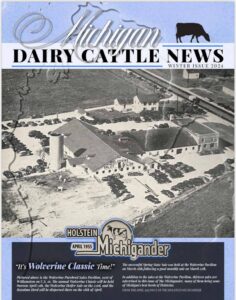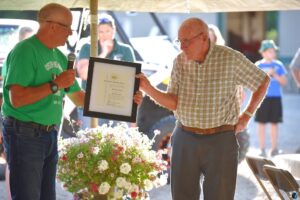By Melissa Hart
On the cover of the recent Michigan Dairy Cattle News is a
photo of the Wolverine Purebred Livestock Sales Pavilion, a massive sales arena
that sat on Grand River between Williamston and Okemos in the 1950s and
60s. This same photo was on the cover of
the 1955 Holstein Michigander, the predecessor of the Michigan-Indiana Holstein
News and the Michigan Dairy Cattle News.
I put that photo on the cover because it harkened back to a
time when the Registered Holstein business was thriving in Michigan. There were sales in every corner of the state
and Michigan Holstien genetics were sought after by breeders from across the
country.
The Wolverine Sales Pavilion was built by Clarence B. Smith
after World War II who came north from Kentucky as an auto worker. His love for cattle led him to manage Baynewood
owned by E.M. Bayne at Romeo, MI. There he developed the great Royal Ormsby,
the 141st cow of the breed to produce over 1000 pounds of fat in one
year. He presented her and her son at
the 1929 Royal Brentwood Sale where Winterthur Farms bought mother and son.
They paid $6300 for the cow and $10,100 for the calf – and added an important
link in their breeding program. Later Smith managed a Guernsey herd at
Pinconning, Michigan.
This auction hotspot served as a hub to not only monthly
sales, but special sales throughout the year.
The Wolverine Classic, the Michigan Holstein State Spring Sale and many
herds were dispersed through here including the Rayulmn herd.
In their January 1955 ad they touted that Michigan Holsteins
had three nominations for All-Americans, nine grand champions, five senior
champions, 14 junior champions, 62 first place winners and 102 other winnings
across the country. The
Wolverine Sales Pavilion was the hotbed of registered livestock that flowed
through from around the Midwest.
From that cover of the magazine, I had two gentlemen contact
me to let me know what they bought from that auction site. One bought a Registered Holstein bull that he
used in his herd and the other bought a heifer and spouted off her full name,
in amazement that he could remember something as obscure as that from a half
century ago but struggled to remember recent history.
In the 1950s and beyond the Michigan Holstein Association enjoyed
a bountiful membership full of people who shared a passion for Holstein
genetics. They had classes of 50 and 60 animals at their State Black &
White show often held at McCurdy Park in Corunna and the district shows were
active with hundreds of head being shown.
The complexion of the Holstein business has
changed in Michigan, and while the old days seem like good ones, keep in mind
that today will be the yesterday we long for tomorrow. Live in the moment and
drink up the feeling of being present so when you look back it will be with
fondness, not regret.




